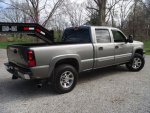If from deflection, crack would have been under the load, not the support. Actually would have bent or folded the beam under the load. Remember, the running gear more or less pivots with the frame. Very little cantilever action unless there is significant load aft of the front axle.
The trick with I beams is to get the load support to the top flange. The beam can hold much more than the web can handle in compression. So you want to add a vertical gusset to help transfer the force to the upper flange.
The other thing was the edge welding of the flange with a gap between the channel and the beam. Didn't help.
The trick with I beams is to get the load support to the top flange. The beam can hold much more than the web can handle in compression. So you want to add a vertical gusset to help transfer the force to the upper flange.
The other thing was the edge welding of the flange with a gap between the channel and the beam. Didn't help.










